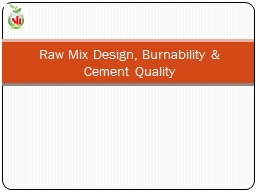PPT-Raw Mix Design, Burnability
Author : grace3 | Published Date : 2023-09-25
amp Cement Quality Cement is Very Old Material 1812 Research by Louis Vicat on Hydraulic Binders 1824 Invention of Portland Cement by Joseph Aspedin 1838 Invention
Presentation Embed Code
Download Presentation
Download Presentation The PPT/PDF document "Raw Mix Design, Burnability" is the property of its rightful owner. Permission is granted to download and print the materials on this website for personal, non-commercial use only, and to display it on your personal computer provided you do not modify the materials and that you retain all copyright notices contained in the materials. By downloading content from our website, you accept the terms of this agreement.
Raw Mix Design, Burnability: Transcript
Download Rules Of Document
"Raw Mix Design, Burnability"The content belongs to its owner. You may download and print it for personal use, without modification, and keep all copyright notices. By downloading, you agree to these terms.
Related Documents














